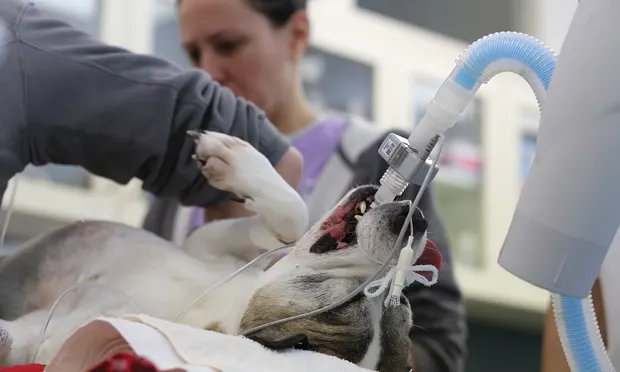Anesthetic Considerations for Geriatric Dogs

Geriatric patients (ie, those that have completed 75%–80% of their expected lifespan) now comprise a larger share of the veterinary patient population than ever—about 25%–33%.1 Although increased age alone does not increase a patient’s anesthesia risk, concurrent health concerns are more likely in older patients.
A dog’s breed, size, nutrition, genetics, and environment can cause his or her chronologic and physiologic age to differ; therefore, developing a treatment plan based on each patient’s history and current status is imperative. Even “healthy” geriatric patients may have underlying organ dysfunction or compromise to their compensatory mechanisms.
Related Article: Anesthesia Tips & Tricks for Veterinary Technicians
Considerations
Age affects both cardiovascular and respiratory systems. Sedation and general anesthesia may lessen older patients’ ability to compensate for cardiovascular changes. Cardiac output and contractility are reduced and, when coupled with decreased ability to autoregulate blood flow and maintain blood pressure, a reduction in cardiac vascular reserve may occur. Changes to the conduction system from chronic or degenerative valvular disease and myocardial fiber atrophy increase the risk for arrhythmias.2
Because decreased blood flow causes increased response time to drug administration, drugs that can potentiate arrhythmias and/or severe changes to the heart (eg, dexmedetomidine, ketamine) should be avoided or titrated carefully to minimize adverse effects. Reduced thoracic wall compliance, decreased lung elasticity, and atrophy of the intercostal muscles causes a reduction in minute ventilation and efficient gas exchange; therefore, oxygen supplementation is key to avoid hypoxia. Mechanical ventilation should be considered.
All medications should be recorded to prevent negative interactions.
Age-related reductions in liver and kidney mass can lead to prolonged metabolism and drug excretion. Hepatic and renal blood flow is also reduced secondary to decreased cardiac output, which results in decreased drug metabolism and clearance. Hypoxia, hypotension, and hypovolemia produced by anesthetic agents may exacerbate reduced renal blood. End-stage liver impairment may lead to prolonged clotting, hypoproteinemia, and hypoglycemia.
Geriatric dogs may also suffer from decreased cerebral perfusion and oxygen consumption. Lower doses of sedative and anesthetic agents may be warranted. Because thermoregulatory function is decreased and shivering during recovery increases oxygen consumption by 200%–300%, intraoperative hypothermia may lead to arterial hypoxemia. While this is true for all anesthetic patients, it is more profound in geriatric patients because of changes in relative fat to muscle mass. Decreased pharyngeal and laryngeal reflexes may present an increased risk of reflux aspiration.
Related Article: Endotracheal Intubation: Preparation Can Be Lifesaving
Before Anesthesia
As with all anesthesia patients, a thorough physical examination and complete medical history are required. All medications should be recorded to prevent negative interactions. CBC, serum chemistry, and urinalysis provide crucial information of underlying disease. Auscultation of the heart and lungs may reveal cardiac murmurs, arrhythmias, or respiratory changes not previously noted. A pre-operative ECG may also be indicated.
IV fluids are useful for patients with subclinical renal impairment or electrolyte imbalances. Renal impairment should be addressed and electrolyte imbalances corrected before anesthesia administration. Fluid overload should be avoided because geriatric patients may have difficulty excreting excess water and sodium, which can lead to CHF and peripheral edema.
Pre-anesthetic fasting should be limited to 8 hours to prevent hypoglycemia, while water should be removed one hour before premedication.
Premedication calms the patient, provides analgesia, and reduces the amount of initial anesthetic and maintenance agent needed (see Table 1). When choosing premedications, the following properties should be considered:
Adverse effects
Minimal metabolism for elimination
Reversibility
Speed of recovery
Toxicity.
Oxygen administration via face mask is recommended before general anesthesia is induced, particularly for brachycephalic and respiratory-compromised patients. Injectable agents should be used and titrated to effect to allow for endotracheal intubation. An additional low dose of a benzodiazapene before induction may make induction and intubation smoother.
During Surgery
Once the patient is intubated, anesthesia is maintained via inhaled volatile anesthetics in 100% oxygen. Minimum alveolar concentration is reduced in geriatric patients, so vigilance is necessary to avoid excessive anesthetic depth and dose-dependent hypotension, hypoventilation, hypothermia, and impaired cardiac contractility. Locoregional analgesia should be performed whenever possible to allow further reduction of the inhalant requirement.
Minimum monitoring of patients during the anesthesia maintenance period includes:
Electrocardiogram for pulse rate and rhythm
Noninvasive blood pressure measurement
Pulse oximetry and capnography to ensure adequate ventilatory support
Temperature measurement.
Depending on the patient’s status and the procedure being performed, invasive blood pressure via arterial catheter, central venous pressure, blood gases, and/or blood glucose monitoring may be necessary and may need to be continued during the recovery period.
A dedicated team member should be responsible for postanesthetic monitoring until the patient is alert and ambulatory.
Recovery
Most anesthetic-related morbidity/mortality occurs during recovery.3 It is crucial to maintain patient comfort with adequate analgesia, padding, and heat support. A dedicated team member should be responsible for postanesthetic monitoring until the patient is alert and ambulatory. The bladder should be emptied before extubation. Because sensory deficits may increase anxiety, additional low-dose sedation may be required. Fluid therapy should be continued to ensure that losses are corrected and perfusion and oxygen delivery at the tissue level is achieved.
If recovery is overly prolonged, any reversible drugs may need to be reversed.
Conclusion
Geriatric canine patients can be successfully anesthetized and recovered. Taking physiologic changes associated with age and medical history into account when formulating a plan is paramount. Vigilant monitoring in the peri- and postoperative periods will help ensure a positive outcome.